Budai Váralagút
Useful Information
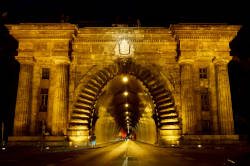
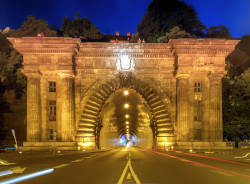
| Location: |
(47.498193, 19.039607) |
| Open: |
no restrictions. [2022] |
| Fee: |
free. [2022] |
| Classification: |
 Tunnel Tunnel
|
| Light: |
 Electric Light Electric Light
|
| Dimension: | L=350 m, W=9.5 m. |
| Guided tours: | self guided |
| Photography: | allowed |
| Accessibility: | yes |
| Bibliography: |
Adam Clark (1843):
Einige Worte über den Bau der Ofner-Pesther Kettenbrücke,
mit Bezug auf die, in öffentlichen Blättern darüber erschienenen Aufsätze.
Aus dem englischen Manuskript übersetzt.
Pesth : Landerer & Heckenast’s Druck. – 24 p., 1843.
 pdf
pdf
|
| Address: | Budai Váralagút. |
| As far as we know this information was accurate when it was published (see years in brackets), but may have changed since then. Please check rates and details directly with the companies in question if you need more recent info. |
|
History
| 1837 | engineer Dániel Novák proposed to connect Pest and Buda with a tunnel. |
| 1838 | William Tierney Clark commissioned in London to design the Chain Bridge in Pest-Buda. |
| 1842 | Count István Széchenyi proposes drilling through Várhegy at the Lánchíd bridgehead in Buda. |
| 1845 | final plan from an engineer named Clark adopted. |
| 1852 | construction company founded by Count István Széchenyi and József Ürményi. |
| 10-FEB-1853 | beginning of construction. |
| 30-APR-1857 | opened to traffic. |
| 1898 | chain bridge over the Danube was named Széchenyi Lánchíd (Széchenyi Chain Bridge). |
Description
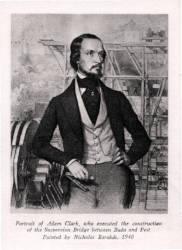
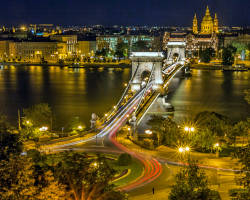
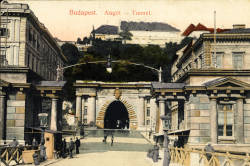
Budai Váralagút (Buda Castle Tunnel), also known as budapesti Várhegy-alagút (Budapest Castle Tunnel), is a popular outlook. The entrance of the tunnel opens to Clark Ádám Square with roundabout and park, and the famous Széchenyi lánchíd (Széchenyi Chain Bridge) is right across. The entrance portal is topped by a huge balcony with a stone railing and offers a nice view on the Danube and the bridge. It is well known to all locals who simply call it the tunnel.
Like the bridge, the tunnel has two lanes and a pedestrian lane. While a walk across the bridge offers views of the city and the Danube, and the air is fresh, the tunnel is frequented by cars, trucks, and buses, the air is quite polluted, and it is very loud. This was obviously quite different in 1857, when it was opened, exhaust fumes did not exist, only horse dung. We suggest to use the public transport to cross the tunnel, bus routes 16, 16B, 105, and 916 pass through the tunnel. Except for the bus fare the visit of tunnel and outlook is free, and it is accessible without any restrictions. As you can see on the pictures it is equally impressive during the night. From the tunnel entrance a funicular brings pedestrians up to the top of castle hill.
The construction started with the founding of the construction company by Count István Széchenyi and József Ürményi in 1852. Construction began in 1853 following the plans of the Scottish engineer Adam Clark who also designed the Chain Bridge, the square between both was named after him. The tunnel was completed in 1857 and opened to traffic. Connecting the Krisztinaváros quarter with the Danube it became immediately quite popular. It was financed by a fee which had to be paid until 1918.
The two cities Buda and Pest, located on different sides of the Danube, always had a great benefit from the river, which allowed the transport of any kind of goods. Nevertheless, they were separated, and it was difficult to cross the river, a boat was required, goods had to be loaded on the boat from carts and back on carts on the other side. Obviously a source of income for the citizens, nevertheless a nuisance for merchants. The Széchenyi lánchíd (Széchenyi Chain Bridge) was the first permanent bridge across the river and thus of great importance. The tunnel, which allowed to cross the castle hill without taking the long way around was the second most important infrastructure of the new city Budapest.
Gróf sárvárfelsővidéki Széchenyi István (*1791-✝1860) (Count István Széchenyi de Sárvár-Felsővidék) was a Hungarian politician, political theorist, and writer. He was one of the greatest statesmen in Hungarian history, reformer, and supporter of modernization, both political and industrial. He concentrated on the development of transportation infrastructure, because of its importance for any development. In 1835, he established the Óbuda Shipyard on the Hungarian Hajógyári Island, which was the first industrial scale steamship building company in the Habsburg Empire. He improved navigation on the Danube by regulation of the flow of waters of the lower Danube, which was dangerous for ships and not efficient until then. This allowed commercial shipping with steam boats and trade from Buda to the Black Sea. He also developed the Tisza River (Theiss) and Lake Balaton. He supported a gradual economic, social and cultural development and opposed radicalism and nationalism. Nationalism was a threat to the multi-ethnic Kingdom of Hungary, because its people were already divided by ethnicity, language and religion. And he wanted to develop Buda and Pest as a major political, economic and cultural center of Hungary. The Chain Bridge was a symbol for the later unification of the two cities as Budapest.
The tunnel was planned by an engineer named Clark. The problem is, that it is hard to say who actually did the design, as William Tierney Clark surveyed the terrain and the first plans came from him, the final construction plans were drawn up by Adam Clark. The two are not related, they are only namesakes. Traditionally it is supposed that Adam Clark was the designer of the tunnel, but there are also arguments that the ideas were actually from William Tierney Clark. And it is clear that William Tierney Clark designed the chain bridge, while Adam Clark executed the construction. Adam Clark completed the final tunnel construction plans in 1851, based on the earlier plans of William Tierney Clark’s office, and he was appointed chief engineer of the construction work. It was his last major work, he died a few years later at the age of 55. He is highly respected in Hungary, a road was named after him, but he refused to accept any awards during his lifetime. He even refused when Ferdinand V wanted to grant him nobility for the construction of the Chain Bridge.
 Search DuckDuckGo for "Budai Váralagút"
Search DuckDuckGo for "Budai Váralagút" Google Earth Placemark
Google Earth Placemark Budai Váralagút
Budai Váralagút  - Wikipedia (visited: 30-DEC-2022)
- Wikipedia (visited: 30-DEC-2022) The Castle of Buda (visited: 30-DEC-2022)
The Castle of Buda (visited: 30-DEC-2022) Index
Index Topics
Topics Hierarchical
Hierarchical Countries
Countries Maps
Maps